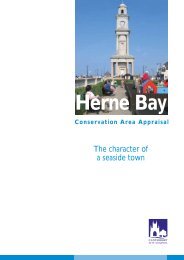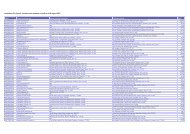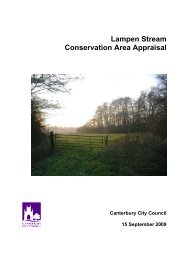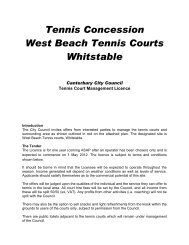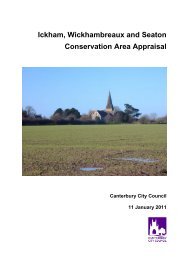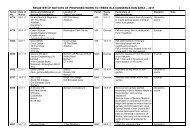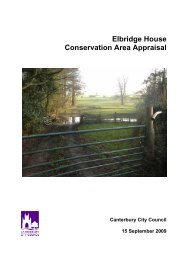Chartham CA Appraisal.qxp - Canterbury City Council
Chartham CA Appraisal.qxp - Canterbury City Council
Chartham CA Appraisal.qxp - Canterbury City Council
Create successful ePaper yourself
Turn your PDF publications into a flip-book with our unique Google optimized e-Paper software.
<strong>Chartham</strong><br />
Conservation Area <strong>Appraisal</strong><br />
June 2005
Introduction<br />
This appraisal outlines the key elements which contribute to the<br />
special architectural and historic character of <strong>Chartham</strong> and<br />
Shalmsford Street. The character of a village is determined by more<br />
than the age and style of buildings. The combination of built form,<br />
shapes, enclosure, materials, spaces and landscape all help create the<br />
character of a place.<br />
Conservation areas were first introduced in 1967 and are defined as<br />
"areas of special architectural or historic interest, the character or<br />
appearance of which it is desirable to preserve or enhance"<br />
(Section 69(1) of the Planning (Listed Buildings and Conservation<br />
Areas) Act 1990.<br />
The <strong>City</strong> <strong>Council</strong> considers that the special interest justifying<br />
designation of a conservation area should be defined and analysed in<br />
a written appraisal of its character and appearance.<br />
Figure 1<br />
The <strong>Chartham</strong> Conservation Area<br />
© Crown copyright. All rights reserved (<strong>Canterbury</strong> <strong>City</strong> <strong>Council</strong>) (100019614) (2005).
Location and population<br />
The <strong>Chartham</strong> Conservation Area (Figure 1) lies approximately three<br />
miles west of <strong>Canterbury</strong> to the south of the A28 (<strong>Canterbury</strong> to<br />
Ashford Road).<br />
<strong>Chartham</strong> is a Downland parish situated within a loop of the Great<br />
Stour. The main settlement with the Parish Church and The Green lies<br />
just to the north of the river. Just to the south is Rattington Street<br />
and a mile to the west is Shalmsford Street. The population of the<br />
parish was 2942 in 1991.<br />
In June 1973 two conservation areas were designated by Kent County<br />
<strong>Council</strong>. One included the Church and the settlement around The Green,<br />
whilst the other included the older properties in Rattington Street.<br />
The enlarged <strong>Chartham</strong> Conservation Area was designated on 10<br />
December 1991 and includes all of the village west of the playing<br />
field, properties around The Old Rectory and Burnt House Farm. The<br />
paper mill buildings are excluded from the Conservation Area. The<br />
Rattington Street area was expanded southwards and is now linked to<br />
the main Conservation area which includes the farmland and water<br />
meadows south of the A28, Deanery Farm and Bolts Hill. Much of<br />
Shalmsford Street is also included, but many of the properties on the<br />
north side of the Street have been altered in such an unsympathetic<br />
way that they have been excluded. Shalmsford Bridge Manor, the<br />
bridge itself and land to the south of Shalmsford Street up to the<br />
<strong>Canterbury</strong> District boundary are also included.<br />
Evolution<br />
The name <strong>Chartham</strong> probably means a settlement in rough pasture.<br />
The village was a manor in 970 and Saxon and Roman relics have been<br />
found in barrows and tumuli in the area. The paper mill was established<br />
on the river in the 17th century becoming an important industry.<br />
The Church of St Mary was built between 1285 and circa 1305 except<br />
for the tower which is late 14th century. Other notable properties<br />
around the Green include De L'Angle House dating from the early<br />
18th century, Bedford House, a 16th century or earlier timber framed<br />
building, The Forge, an 18th century two storey red brick house with<br />
attics, and The Old Kings Head, 16th century or earlier and timber<br />
framed refaced with brick and tile.<br />
At Rattington Street there is a fine group of historic buildings<br />
including The Artichoke Inn, a late 15th century timber framed<br />
building and Rentain Farmhouse, an 18th century red brick building<br />
of two stories with attics.
Burnt House Farmhouse is of 17th century date, with an attached<br />
18th century oast. The 18th century red brick barn and the dovecote,<br />
built over a henhouse with a pig sty in the basement, within the<br />
complex are both listed Grade II as is Park House opposite.<br />
In 1303 Prior Henry of Eastry built a hall at Deanery Farm. A kitchen and<br />
chamber block followed and at the Reformation were handed over to<br />
the newly established Dean and Chapter of Christ Church Cathedral.<br />
The complex was adapted and partly rebuilt in 1745. It is listed Grade<br />
II*. Close by is Court Lodge, a timber framed Wealden house built in<br />
1496 for the tenant farm ('Firmarius') by Prior Goldstone II. Other<br />
buildings within the complex include part of the Priors Great Stable of<br />
circa 1500 altered in the early 19th century. South of the railway are<br />
18th and 19th century red brick buildings including a granary.<br />
The name Shalmsford Street means ford by a shambles or slaughter<br />
house. There are several attractive brick buildings here including 18th<br />
century Barn Cottages (10-18 Shalmsford Street, Grade II), Shalmsford<br />
Farmhouse of similar date and early 19th century Box Tree Cottages.<br />
Shalmsford Bridge Manor is a timber-framed house dating from the<br />
16th century or earlier and just down-river is the mid-19th century<br />
<strong>Chartham</strong> Corn Mill, of painted brick.<br />
Extract from Andrews, Drury and Herbert<br />
Topographical Survey of Kent 1768
Glimpse through hedgerow along the<br />
A28 towards <strong>Chartham</strong> village centre<br />
Landscape setting<br />
The Conservation Area covers a wide diversity of features including<br />
the water meadows contained within the spacious loop of the<br />
Ashford Road (A28), the agricultural landscape to the south of the<br />
meadows, the open development around The Green and the Parish<br />
Church, the compact settlement at Rattington Street, the linear<br />
development at Shalmsford Street and the tree-topped Downland<br />
which forms a backdrop to the south.<br />
Ashford Road, constructed early in the 19th century, follows the edge of<br />
the Stour water meadows. The agricultural slopes to the west and north<br />
of the road are largely excluded from the Conservation Area with the<br />
exception of Old Manor Farm and the adjoining orchards, the banks<br />
and trees around the sharp bend to the north, Nickle Cottages and the<br />
Cemetery landscaping and trees. There are many important roadside<br />
trees particularly on the southern side of the A28 and surrounding The<br />
Corn Mill and its ancillary buildings and Mill House which are, in<br />
themselves, an important feature of the Conservation Area.<br />
The water meadows alongside the Great Stour in this region represent<br />
the largest unspoiled area of waterside meadows left in this part of<br />
Kent and form an outstanding setting for the various settlements and<br />
groups of historic buildings within <strong>Chartham</strong> parish. Sand and gravel<br />
extraction is at present taking place but this operation is covered by<br />
conditions which require full reinstatement.<br />
Trees are a special feature of the riverside meadows and there are<br />
other important groups at Deanery Farm, around the paper mill and<br />
along the top of the ridge to the south. The hop-garden at Deanery<br />
Farm is an increasingly rare example of a once-common and<br />
picturesque crop. There is a considerable contrast between the flat<br />
landscape alongside the river at the northern edge of the<br />
Conservation Area and the Downland at the southern edge.
Main character areas<br />
Shalmsford Street<br />
For the purposes of this appraisal, The <strong>Chartham</strong> Conservation Area<br />
has been divided into seven character areas:<br />
Station Road<br />
The Green<br />
Riverside<br />
Cemetery, <strong>Chartham</strong> Corn Mill and Nickle Farm<br />
Rattington Street<br />
Shalmsford Street<br />
Bolt’s Hill<br />
Station Road<br />
Cemetery, <strong>Chartham</strong> Corn Mill<br />
and Nickle Farm<br />
Bolt’s Hill<br />
Park House, which dates from the early 19th century, occupies a<br />
prominent, elevated corner position above the village at the junction<br />
of Hatch Lane and the A28. It is Grade II listed and retains all its<br />
original, external architectural features. The property is bounded by<br />
white painted railings and has steps down to street level.<br />
To the east is a former telephone exchange, now a dwelling, and<br />
further back from the road is the Rectory, screened by a wide belt of<br />
mature hedges and trees.<br />
From the tree-lined A28 there are occasional glimpses of the village<br />
below with distant views to farmland and hills in the south-east. The<br />
noise and speed of the traffic and the narrow pavements along this<br />
stretch of the A28 forms a 'barrier' between this corner and the rest of<br />
the Conservation Area.<br />
Riverside<br />
The Green<br />
Station Road<br />
Rattington Street<br />
© Crown copyright. All rights reserved (<strong>Canterbury</strong> <strong>City</strong> <strong>Council</strong>) (100019614) (2005).<br />
Park House on the corner of Hatch Lane<br />
Clutter of signage at entrance to village
View into village from the A28<br />
Station Road Schematic appraisal<br />
G<br />
V<br />
R<br />
Local landmark<br />
Significant building<br />
Significant trees<br />
Special sense of place<br />
Vista<br />
Glimpse<br />
View<br />
Activity/nodal point<br />
Visual rhythm<br />
V<br />
R<br />
G
Looking south from Hatch Lane, <strong>Chartham</strong> village sits in the Stour<br />
Valley. To the right, a belt of mature trees borders the exit lane from<br />
the village and to the left, the low-lying buildings of Burnt House<br />
Farm present a roofscape of Kent peg tiles which lead the eye down<br />
Station Road and into the village. From this vantage point, the tower<br />
of St. Mary's Parish Church commands a prominent position although<br />
this view is spoilt by overhead wires and telegraph poles, one of<br />
which is situated in the front garden of 'The Oast House', a Grade II<br />
building forming part of Burnt House Farm.<br />
Burnt House Farm<br />
Burnt House Farm consists of a cluster of listed buildings, located<br />
close to the Ashford Road boundary of the Conservation Area. The<br />
cluster of buildings at Burnt House Farm form a key entry point to the<br />
Conservation Area and make a positive contribution to this part of the<br />
Conservation Area. However, their wider setting is spoilt slightly by<br />
the adjacent railway and the busy A28 which are detrimental to the<br />
area, particularly in terms of noise.<br />
Burnt House Farmhouse and the Oast House are a group of Grade II<br />
listed cottages formerly known as Burnt House Farm and Burnt House<br />
Farm Cottages. The main farmhouse is a 17th century 2-storey<br />
building with attic in the gable end. The roof is tiled in traditional<br />
Kent peg tiles and the windows feature sashes. The Oast house forms<br />
an L-shaped block to the southeast and dates from the 18th century.<br />
It is constructed in similar materials to Burnt House Farmhouse and<br />
also features some sash windows. In addition, it has a doorcase with<br />
pilasters, projecting cornice, rectangular fanlight and 6-panelled door.<br />
The barn at Burnt House Farmhouse, which is situated to the north of<br />
the farmhouse and backs on to Station Road, is the building that is<br />
most clearly visible from Station Road. The barn dates from the 18th<br />
century or earlier and is constructed of red brick with loop lights. It<br />
has a tiled catslide roof with projecting hip over the wagon entrance<br />
on the south side and queen posts inside.<br />
Opposite Burnt House Farm, Apsley Cottages face north east with a<br />
triangular area of rough tarmac facing the road, resulting in a negative<br />
contribution to the appearance of the road frontage at this point.<br />
Buildings at Burnt House Farm<br />
Apsley Cottages
Top: The former Railway Tavern.<br />
Centre: <strong>Chartham</strong> signal box,<br />
dated 1888. Above: View from<br />
railway footbridge across flat<br />
workshop roofs<br />
The Railway Crossing<br />
Immediately before the level crossing is the former Railway Tavern<br />
public house. The remnants of a Fremlin's Brewery sign painted onto<br />
the brickwork on the south elevation indicate the building's earlier use.<br />
The wooden gates of the level crossing are still operated manually<br />
and a green painted clapboard signal box dating from 1888, sited<br />
behind a white picket fence, also continues to be staffed.<br />
The footbridge at <strong>Chartham</strong> Station, which lies outside the<br />
Conservation Area, allows good views over the village, which are<br />
spoilt by the flat asphalt roofs of the adjacent garage and associated<br />
workshops, which are also outside the Conservation Area boundary.<br />
Continuing south along Station Road, the rear boundaries of De<br />
L'Angle Row cottages form the boundary of the Conservation Area.<br />
Many of these properties retain their iron railings to the street but<br />
most have been adapted to provide parking areas although the<br />
overall impression, due to the choice of planting, remains that of<br />
small 'country cottage' style gardens.<br />
The village shop is a good meeting place for the community and<br />
introduces activity to this part of the village along with additional<br />
vehicular traffic and parking issues.<br />
Rear of De L’Angle Row cottages. The village shop
St Mary's Church<br />
At the junction of Station Road and Church Lane stands St. Mary's<br />
Church, which dates back to the 13th century. The whole was<br />
restored by G E Street in 1875. Built of flint with stone dressings and<br />
tiled roof, it contains fine examples of Kentish tracery to the transept<br />
windows and one of the oldest brasses in the country, dated 1306.<br />
The churchyard is enclosed by a flint wall with a lych gate at the west<br />
end and contains 18th century headstones with skull, cherub,<br />
hourglass and anchor motifs as well as a number of mature trees.<br />
Church Lane, running along the northern boundary of the<br />
churchyard, leads to The Green as does Parish Road, immediately<br />
south of the railway. These roads converge at the western end of The<br />
Green, which is triangular in shape and an important open public<br />
space in the village.<br />
Parish Road has some modern buildings in a mixture of Kentish<br />
vernacular styles that follow the building line defined by the road<br />
itself and by historic buildings on the north side of The Green. The<br />
variation of height and orientation blends in well with the village<br />
character.<br />
Recent development along Parish Road<br />
opening onto narrow pavement and<br />
respecting the existing building line.<br />
The west end of St. Mary’s Church<br />
showing war memorial and lych gate
The Green Schematic appraisal<br />
G<br />
V<br />
R<br />
Local landmark<br />
Significant building<br />
Significant trees<br />
Special sense of place<br />
Glimpse<br />
View<br />
Visual rhythm<br />
Left: The former King’s Head public house.<br />
Right: <strong>Chartham</strong> signal box, dated 1888.<br />
Below: De L’ Angle Row from The Green.<br />
The Green<br />
V<br />
G<br />
R
Most of the buildings around The Green are either listed or of some<br />
architectural interest and give a sense of enclosure to this area. At the<br />
western end is the former King's Head public house dating from the<br />
16th century or earlier, and a group of houses and cottages which are<br />
on or close to the road. A Grade II listed K6 telephone kiosk stands on<br />
that 'point' of the green.<br />
At the eastern end the buildings are mostly set back from the road<br />
behind walls and railings with De L'Angle Row having a large but very<br />
important garden area in front of it surrounded by a low brick wall.<br />
The early 18th century De L'Angle House is thought to have been built<br />
by John Maximilien de L'Angle, a Huguenot refugee who was Rector<br />
of <strong>Chartham</strong> between 1696 and 1724 and also a Canon of <strong>Canterbury</strong><br />
Cathedral. In the centre of the second floor is a round-headed niche<br />
containing a half-length stone statue of Charles II which originally<br />
stood on a pedestal in the garden.<br />
Above left: De L’Angle House.<br />
Above right: River Court to the south<br />
of The Green. Mature trees retained to<br />
enhance and give character to a 20th<br />
century housing development.
Riverside Area Schematic appraisal<br />
Riverside Area<br />
The River Stour is a key element of the landscape setting of both<br />
<strong>Chartham</strong> Parish and the Conservation Area. The river is clearly visible<br />
from several points in the Conservation Area - notably as it flows<br />
alongside the Paper Mill area and associated buildings, past River<br />
Court, parallel to properties on Riverside and along the A28 boundary<br />
of the Shalmsford Street settlement.<br />
The river has historically been critical to the functioning of the paper<br />
mill. Access to it by the paper mill is possible although the area<br />
would benefit from some environmental and access enhancements,<br />
whilst ensuring that the tranquil, rustic feel of the area is retained.<br />
V<br />
V<br />
V<br />
GV<br />
Local landmark<br />
Significant building<br />
Significant trees<br />
Special sense of place<br />
Quiet area<br />
Vista<br />
View<br />
Activity/nodal point
At River Court, the Stour is an important element of the setting of the<br />
properties, with the back gardens of the properties sloping down<br />
towards the river bank. This setting is enhanced by the water<br />
meadows beyond the River, which contain a group of concrete tank<br />
traps as a interesting wartime relic.<br />
The river is also a key characteristic of Riverside. This area is accessed<br />
by crossing the railway line and the commencement of the row of<br />
properties is marked by a 19th century, painted, brick building<br />
adjacent to the railway, a former crossing keeper’s cottage. The<br />
properties along Riverside are generally 2-storey semi-detached or<br />
terraced cottage-style properties, dating from the late Victorian<br />
period apart from the picturesque,17th century Oast Cottage which is<br />
Grade II listed. They are accessed by a path which runs alongside the<br />
tree lined riverbank.<br />
Progressing further along the riverside, the area becomes more<br />
secluded and there are several detached properties of individual<br />
character which are set back from the river. The character of Riverside<br />
changes again as you reach the junction with the A28 as this becomes<br />
a key defining feature of the area. The volume of traffic and noise<br />
leads to it having a negative effect on the end of Riverside which<br />
adjoins it. By contrast, the rest of Riverside is characterised by being<br />
secluded and quiet.<br />
Below and right: Views from Riverside<br />
Above: Pedestrian only level crossing<br />
entrance to Riverside.<br />
Left: Crossing keepers cottage indicates<br />
that vehicular crossing gates were once<br />
installed at this point .<br />
Below: Oast Cottage, dating from the<br />
17th century.
Local landmark<br />
Significant trees<br />
Special sense of place<br />
Quiet area<br />
Vista<br />
Cemetery, <strong>Chartham</strong> Corn Mill<br />
and Nickle Farm<br />
Cemetery and <strong>Chartham</strong> Corn Mill Schematic appraisal<br />
Situated on the northern edge of the A28, the 19th century Cemetery<br />
with contemporary Chapel and Lodgehouse is surrounded by tall, cast<br />
iron railings. An extension to the original site, again surrounded by<br />
railings, has been added to the west. A border of trees clearly defines<br />
this landscaped area amongst the surrounding arable farmland.<br />
Immediately south west of the cemetery and south of the A28 is<br />
<strong>Chartham</strong> Corn Mill (Grade II listed) and Corn Mill House with<br />
associated buildings (all converted to residential use) and former mill<br />
workers cottages. The Great Stour forms the southern boundary to<br />
this complex. The river flows over a wier that formed part of the mill<br />
workings and this, in turn, is crossed by a footbridge leading to a<br />
public footpath across fields to Shalmsford Street.
Continuing along the A28 to the west, the conservation area includes<br />
the entrance to Nickle Farm. Nickle Cottages, two terraces of four<br />
cottages, face the A28 to the west of the farm entrance. Numbers 1<br />
and 2 Nickle Gate Cottages stand to the east of the entrance with 1 to<br />
3 Nickle Bank Cottages behind them. All these buildings date from<br />
the late 19th to early 20th century. The recently constructed<br />
Nicklegreen Farmhouse stands on the west side of the farm entrance.<br />
Both sides of the A28, along this northern boundary of the<br />
conservation area, are lined with dense belts of mature trees. Within<br />
the loop of the A28 these large shading trees allow glimpses through<br />
towards <strong>Chartham</strong>, over flat grazing land surrounding the<br />
meandering River Stour.<br />
Nickle Farm Schematic appraisal<br />
Above: Buildings within the <strong>Chartham</strong> Corn Mill complex<br />
Top: Nicklegreen Farmhouse<br />
Centre: Nickle Gate Cottages.<br />
Above: Nickle Cottages<br />
Below: View through the tree lined A28
Below: Sequential views, looking north,<br />
along Rattington Street showing the<br />
narrow country lane entering the<br />
enclosure of the built form.<br />
Rattington Street Area<br />
Approaching Rattington Street from the south, the farm store<br />
buildings associated with Rentain Court Farm are immediately to the<br />
east/north-east of Rattington Street and are not included in the<br />
Conservation Area. However, this is a significant entry point as at this<br />
juncture of Rattington Street, which is in the Conservation Area, a<br />
change in the character of the road occurs. Up until this point,<br />
Rattington Street is a country lane lined with hedges and agricultural<br />
land. As you progress past Rentain Court Farm the character of<br />
Rattington Street changes as is signified by a glimpse of a cluster of<br />
historic buildings.<br />
Set at a slightly elevated position, on the eastern side of Rattington<br />
Street, is a cluster of 19th century cottages with small front gardens<br />
and post-war bungalows adjacent to the north. The bungalows are<br />
not of the same vernacular style as the rest of the properties and they<br />
do result in a break in the character of the Conservation Area.<br />
However, they do not constitute a significant threat to the character<br />
of the Conservation Area at this point, partly as landscaping to the<br />
front of them reduces their impact on the streetscape.<br />
Rentain Farmhouse, an 18C listed building on the southwest side of<br />
Rattington Street, close to the junction with Bakers Lane, initially<br />
dominates the view as you proceed in a northwesterly direction from<br />
the 19th century cottages. Rentain Farmhouse is a detached building<br />
originally constructed of red brick tiles, which have now been painted<br />
cream. It features sash windows, a porch with pediment over it, a<br />
hipped tiled roof and it has a brick wall to the front of it which<br />
increases in height at the boundary with Bakers Lane.<br />
Approaching Rentain Farmhouse, the streetscape becomes<br />
increasingly interesting, as the initial glimpse of the main cluster of<br />
historic buildings on Rattington Street develops, with the corners and<br />
curvature of the road, adding even more intrigue. The character of<br />
the area is however damaged slightly at this point by several modern<br />
additions including pylons and a yellow grit salt box, on the grass<br />
triangle at the junction of Bakers Lane and Rattington Street.<br />
At the grass area in front of Rentain Farmhouse, looking northeastwards<br />
the southern and western side of Hope Cottage, a Grade II<br />
listed 18th century property is in the immediate foreground. Hope<br />
Cottage features sash windows which are characteristic of the 18th<br />
century properties found in this, the main cluster of historic buildings,<br />
on Rattington Street. It effectively marks the entrance to the area of<br />
Rattington Street which is of the most significant interest in<br />
conservation terms.<br />
Viewing Rattington Street from Rentain Farmhouse, the townscape<br />
and architectural character of the core area of central buildings, all of<br />
which are Grade II listed, begins to emerge. The Bakery and Nos 1 and<br />
2 Rattington Street, on the north-east side of Rattington Street can be<br />
seen. This cluster of adjoined buildings are 2 storeys high plus 3
Rattington Street Schematic appraisal<br />
V<br />
V<br />
V<br />
5<br />
6<br />
4<br />
3<br />
2<br />
V<br />
Local landmark<br />
Significant building<br />
Significant trees<br />
Special sense of place<br />
Vista<br />
View<br />
Activity/nodal point<br />
Intrusive feature<br />
Sequential view<br />
1
Top: The medieval timer framing of<br />
the Artichoke Inn adds variety and<br />
interest to the street.<br />
Centre: Rattington House.<br />
Above: <strong>Chartham</strong> Mill terminates the<br />
view at the northern end of<br />
Rattington Street.<br />
dormers and dated 1733, featuring sash windows and a tiled roof.<br />
The townscape of the area is damaged slightly at this point by the<br />
telegraph pole immediately south of Hope Cottage, which has the<br />
effect of obliterating the otherwise clear view between Hope Cottage<br />
and The Bakery and adjoining residences.<br />
Continuing along Rattington Street towards the properties north of<br />
Hope Cottage, the curvature of the road creates an interesting and<br />
intriguing townscape. As you proceed, around the corner past The<br />
Bakery and Nos 1 & 2 Rattington Street, the other listed buildings on<br />
the southwestern side of the road which have not previously been<br />
visible, begin to come into view. These include three 1722 buildings<br />
now known as The Post Cottage, Post House and Middleton Cottage,<br />
which are similar in style to The Bakery and associated houses). Whilst<br />
the similar styles of buildings on both sides of the street gives the<br />
built form of the area a unified feel, there is variety in the individual<br />
buildings which makes the townscape very interesting.<br />
Proceeding past the Post House and associated buildings, what could<br />
be described as the building with the most significant character in the<br />
Rattington Street area comes into view. The Artichoke Inn, one of the<br />
public houses in the village dates from the late 15th century to early<br />
16th century and is a timber framed building of two storeys with a<br />
tiled roof. It forms a focal point to the Rattington Street element of<br />
the Conservation Area. However, it setting is spoilt slightly by its car<br />
park, located on the opposite side of the road which is at best a<br />
bland, neutral feature of this area.<br />
It is not just the frontage of The Artichoke Inn which contributes to<br />
the character of this part of Conservation Area. Approaching The<br />
Artichoke from the north via the track which runs parallel to Rentain<br />
Road, the variety which the rear of the properties on the south-west<br />
of Rattington Street contribute towards the Conservation Area can be<br />
best appreciated. The catslide roofs are clearly visible from this angle.<br />
The road is untarmaced and lined with vegetation, with the rears of<br />
the properties on Rattington Street backing directly on to it,<br />
emphasising the close knit nature of the built form of this area.<br />
However, on the side of the track which is closest to Rentain Road, the<br />
feel of the area, is spoilt slightly by unsympathetic wooden fences and<br />
storage buildings which face on to the track.<br />
Slightly further north from The Artichoke on the opposite side of<br />
Rattington Street are a series of properties arranged around a central<br />
garden area which fronts on to the road, being partly separated from<br />
it by a low picket fence. The 2 properties, listed collectively as<br />
Rattington House which face on to Rattington Street adjoin each<br />
other and are two-storeys, with half the brick painted white and<br />
rooms in their catslide tiled roofs. The other property which is at right<br />
angles to the adjoined houses, dates from 1746 and is constructed of<br />
red bricks with a tiled roof and attractive detailing to the windows<br />
and doors. To the rear of this group of houses is Willow House, a 2storey<br />
brick property, painted in cream and with pitched roof to the<br />
front and catslide tiled roof to the rear and a 1-storey annex, possibly<br />
a recent extension. This property is largely shielded from view on
Rattington Street by fencing and vegetation but the entrance to it is<br />
located on Stour Road. The properties on Stour Road are<br />
1960's/1970's bungalows and they spoil the setting of Willow Cottage<br />
to some extent. However, overall this group of properties, enhance<br />
the character of the Conservation Area as whilst their style is<br />
appropriate to their context in Rattington Street, each property has its<br />
own wealth of individual features adding interest to the townscape<br />
Riverview Cottage is set further along on the road, almost<br />
immediately in front of Willow Cottage and it follows the sharp<br />
curvature of Rattington Street at this point. Riverview Cottage is<br />
Grade II listed, of two storeys in scale, with a tiled roof and hipped<br />
dormer. Partly weatherboarded and partly brick, both painted white,<br />
these features distinguish it from the other buildings in this area, in<br />
terms of its vernacular style. Its location on the curvature of the road,<br />
also makes it a key entry point to the main cluster of buildings on<br />
Rattington Street because as you approach Rattington Street from the<br />
north, it is from Riverview Cottage that you get the first glimpses of<br />
the building on the south-west side of Rattington Street, with The<br />
Artichoke initially dominating the view.<br />
<strong>Chartham</strong> Mill<br />
<strong>Chartham</strong> Mill is not currently included in the <strong>Chartham</strong> Conservation<br />
Area. However, it is a key feature of the townscape surrounding the<br />
Conservation Area, particularly the Rattington Street element. The<br />
current main mill building was built in 1949 and is set alongside a<br />
series of buildings associated with the paper mill, none of which are<br />
listed. However, this building is a symbol of an industry which has<br />
been of great importance to <strong>Chartham</strong>'s economy historically, with<br />
the first paper mill having been built in 1738 and subsequently<br />
destroyed by fire. Prior to this, corn mills and mills for woollen cloth<br />
are said to have existed in <strong>Chartham</strong> from the middle ages.
Above: The busy, tree lined, A28 at the<br />
junction with Shalmsford Street.<br />
The main mill building dominates the view as you approach the<br />
corner of Rattington Street adjacent to Riverview Cottage. It is three<br />
storeys in scale, with leaded windows and painted white. The view of<br />
the building line of the mill is however obliterated by a series of<br />
powerlines on the south-west side of Rattington Street, adjacent to<br />
some 1960/70s bungalows which have a negative effect on the<br />
setting of both Riverview Cottage and the mill. Aside from the main<br />
mill building, there are a series of ancillary buildings, of varying<br />
quality, which straddle either side of the main road. For example, the<br />
corrugated iron storage sheds on the north-east side of Rattington<br />
Street are in a poor state of repair and make a negative contribution<br />
to the area. There are also a series of tarmaced and gravel areas with<br />
no formal boundaries which again form an unattractive frontage on<br />
to the main road.<br />
The setting of the mill next to the River Stour, which is critical to the<br />
existence of the mill industries, creates an environment which is<br />
potentially very attractive. For example there is a pleasant, heavily<br />
vegetated footpath along the edge of the river, a key area for wildlife.<br />
From here the former worker's cottages which are representative of<br />
the historical importance of the mill to the community can be<br />
partially glimpsed. They are now boarded up and this area would<br />
benefit from environmental enhancements within the confines of the<br />
existing building line, provided the secluded quality of the area<br />
around the cottages was preserved.<br />
Shalmsford Street<br />
The northern boundary of the Conservation Area is the north side of<br />
the A28 which follows the curve of the Great Stour. This tree-lined<br />
route includes the 19th century Cemetery with its small contemporary<br />
chapel and lodge and, to the south of the road, <strong>Chartham</strong> Corn mill<br />
(Grade II listed) and associated buildings. Nickle Cottages and Nickle<br />
Gate Cottages at the entrance to Nickle Farm are also included just<br />
before the road swings southwards.<br />
From this point the A28 passes through a much wider belt of mixed<br />
broad leafed trees, both on the slopes of the valley to the west and on<br />
the edge of the water meadows to the east.<br />
Secluded in its elevated position amongst this dense planting is<br />
Shalmsford Bridge Manor, a Grade II listed, timber framed house<br />
dating from the 16th century or earlier and Shalmsford Oast and Old<br />
Manor Barn.<br />
Turning east from the A28, a fine red brick bridge over the Great Stour<br />
caters for vehicular traffic at this busy road junction but has<br />
inadequate pedestrian provision.<br />
The road to Shalmsford Street is across wide water meadows with<br />
distant vistas to the hills and trees that surround this low-lying linear
settlement. The first buildings from this approach are Boxtree<br />
Cottages on the left. A pair of early 19th century brick cottages with<br />
gardens that are open to the road.<br />
The entrance to Shalmsford Farm has an air of dereliction about it<br />
with several untidy buildings and rusting farm machinery visible from<br />
the road, whilst further along on the opposite side of the road, The<br />
George Inn public house has a large expanse of failing tarmac<br />
adjacent to the carriageway for car parking. These two areas would<br />
benefit from some form of landscaping.<br />
The 18th century Shalmsford Farmhouse, fronted by a tall hawthorn<br />
hedge, on the left and nos.10 to 18 on the right (also 18th century)<br />
are the most significant buildings in this part of the Conservation<br />
Area. All are Grade II listed They are surrounded by a mixture of 1960's<br />
and 1970's houses and bungalows, roofed in concrete tiles. These infill<br />
properties do not follow the street line and have open gardens and<br />
driveways to the street and do not contribute to the Conservation<br />
Area.<br />
The corner of Shalmsford Street and Thruxted Lane has a row of<br />
cottages dating back to 1743, finished in painted render and<br />
brickwork.<br />
Thruxted Lane is bounded on one side with a mix of hedgerow and<br />
trees. On the other side, chestnut pale fencing borders the playing<br />
field. From here there are views to the back gardens of the properties<br />
Above left: View across water meadows<br />
towards Boxtree Cottages and distinctive<br />
oast cowls at Shalmsford Farm from<br />
Shalmsford bridge<br />
Left: View across water meadows<br />
looking east.<br />
Above Boxtree Cottages<br />
Below: Oast cowls and farmyard<br />
entrance at Shalmsford Farm
Shalmsford Street Schematic appraisal<br />
V
V<br />
Local landmark<br />
Significant building<br />
Significant trees<br />
Special sense of place<br />
Quiet area<br />
Vista<br />
View<br />
Activity/nodal point<br />
Intrusive feature
Top: View along Thruxted Lane looking<br />
south west.<br />
Centre: Pedestrian level crossing on<br />
Thruxted Lane<br />
Above: Former Methodist Chapel on<br />
Shalmsford Street.<br />
Top right: View along Shalmsford Street<br />
looking south east from Shalmsford Farm.<br />
Centre: View along Shalmsford Street<br />
looking east, showing modern properties<br />
to the right.<br />
Above: Former Methodist Chapel on<br />
Shalmsford Street.<br />
along Shalmsford Street, which gives a cluttered appearance. Some<br />
have close boarded fences of varying heights. There are also distant<br />
views towards the slopes of the valley.<br />
Thruxted Cottage stands isolated from the rest of the village<br />
between the southern tip of the playing field and the railway line<br />
that crosses the lane. A pedestrian crossing point gives access to the<br />
rest of Thruxted Lane, which lies outside the Conservation Area in<br />
Ashford District.<br />
Returning to Shalmsford Street, the Conservation Area includes a<br />
small group of painted and pebbledashed cottages and former<br />
Methodist chapel that stand opposite the Thruxted Lane junction.
Bolts Hill looking north east<br />
Bolts Hill has a character quite distinct from that of Shalmsford Street.<br />
Occupying an elevated position with commanding panoramic views<br />
over fields towards <strong>Chartham</strong> village, its buildings follow the road as it<br />
snakes its way down to the valley bottom and its assortment of farm<br />
related buildings.<br />
This part of the Conservation Area is entered at the crest of the hill<br />
with a line of mature trees on the right and modern housing<br />
development to the left. A large, metal clad, industrial shed lies<br />
outside the area screened from the road by the trees, but due to its<br />
prominent position, is highly visible from the Riverside/Parish Road<br />
area, emphasising its negative contribution to the area.<br />
The former Cross Keys public house, on the right, has been<br />
sympathetically converted into dwellings with lawns and picket fence.<br />
New houses follow the curvature of the corner, and the eye is drawn<br />
to a pair of mid 19th century houses sitting high on the bank in<br />
mature gardens. As the new houses follow the natural curvature of<br />
the road, this helps them to fit in well with the existing streetscape.<br />
Further along is the British Legion Club with its large open tarmac<br />
parking area in front. A public footpath leading across farmland to<br />
Rattington Street can be accessed from behind this building. Next to<br />
the club are three modern properties set back from the street line and<br />
Box Tree Cottages, dating from the 18th century. The most dominant<br />
building viewed from here is a former oast house which is, at the time<br />
of writing, being converted into apartments.<br />
The building line fragments as the road leads towards <strong>Chartham</strong><br />
village through low lying open fields that typify the landscape setting<br />
of the larger part of the Conservation Area. An interesting collection<br />
of flint agricultural buildings and walled enclosures, in near ruinous<br />
state, lie between the oast and Deanery Farm Cottages. A brick and<br />
flint, two storied, granary stands within the curtilage of these cottages.<br />
Left: View towards <strong>Chartham</strong> village<br />
centre from Bolts Hill<br />
Below: The former Cross Keys public<br />
house, now converted to residential use.<br />
Top: New houses next to the former Cross<br />
Keys public house.<br />
Centre: Elevated 19th century houses<br />
situated in mature gardens.<br />
Above: British Legion Club with wide,<br />
open frontage onto the street.
Bolts Hill Schematic appraisal<br />
Above: Box Tree Cottages.<br />
Above right: Former oast house under<br />
conversion to dwellings.<br />
Far right: Buildings at Deanery Farm.
Local landmark<br />
Significant building<br />
Significant trees<br />
Special sense of place<br />
Quiet area<br />
Vista<br />
Activity/nodal point<br />
Intrusive feature<br />
Right: Unspoilt view from the footpath<br />
that links Bolts Hill to Rattington Street.<br />
Important roofscape within the village.<br />
The unmade road makes a valuable<br />
contribution to the rural character of this<br />
‘hidden’ part of the village.<br />
Opposite this building is the old village school. The larger part of the<br />
school buildings is now a doctors' surgery. Part remains boarded-up.<br />
Black iron railings still surround the playground. The school grounds<br />
to the rear now contain a modern housing development.<br />
Deanery Farm<br />
Deanery Farm consists of a collection of buildings and associated land,<br />
positioned either side of the juncture of Parish Road and Bolts Hill.<br />
Several of the buildings are of particular historic significance with the<br />
Deanery said to have been the centre of village life in the Middle Ages.<br />
Approaching from Parish Road, the collection of buildings at Deanery<br />
Farm on the south-west side of Bolts Hill are not clearly visible, other<br />
than from the footpath running parallel with the properties on<br />
Riverside, which runs almost at right angles to Parish Road. From<br />
Bolts Hill, the buildings can only be seen once you have passed under<br />
the railway track arch which separates Deanery Farm from the southwest<br />
side of Bolts Hill. The railway arch therefore forms a significant<br />
physical boundary between this element of Deanery Farm and the<br />
rest of settlement at Bolts Hill. After passing under the railway arch, a<br />
gravelly track provides access to Deanery Farm, although the<br />
buildings cannot be fully appreciated until you proceed off the track<br />
and into the courtyard area in the middle of the main collection of<br />
farm buildings.<br />
Several of the buildings at Deanery Farm are listed, with The Deanery<br />
being Grade II* listed. The Deanery has an exterior dating from 1722<br />
but with interior features dating back to 1303, containing the open<br />
hall built by Prior of Eastry. It is a 2-storey red brick building with tiled<br />
roof in 3 hips, parapet, stringcourse and seven sashes. The rainwater<br />
head is dated 1745 but there are modern additions to the building to<br />
the north-east and the south-east front centre portion. It is<br />
characterised by 2 Venetian windows separated by a wide porch with<br />
fluted columns one each side, a modern gabled portion of 2 storeys<br />
and attic being in place of the original projecting wings. The Grade II<br />
listed Wealden-style Cottages are also important and date from 1495.
Materials<br />
The <strong>Chartham</strong> conservation area includes buildings from the 16th to<br />
the 21st century. Kent peg tiling predominates as the roofing material<br />
for most of the historic buildings with slate being introduced from the<br />
19th century onwards. Some injudicious changes to concrete tiles<br />
feature on these later properties.<br />
Early timber framing is evident around the Green and Rattington<br />
Street alongside red brick construction dating from the 17th to the<br />
19th century, of which many have been painted or rendered. Some<br />
buildings of a similar period and construction (and alteration) can be<br />
found at Bolts Hill and Shalmsford Street, although not in the same<br />
condensed built form. Early 20th century red brick properties exist<br />
throughout all parts of the conservation area as well as extensive<br />
modern infill of varying styles and materials, especially along<br />
Shalmsford Street.<br />
Throughout the conservation area, statutory listed buildings have<br />
retained their original door and window joinery but properties not<br />
subject to the same legislation tend to have undergone some<br />
alteration to their fabric.
Strengths, Weaknesses, Opportunities and<br />
Threats Analysis<br />
In order to assess how the character or appearance of the<br />
Conservation Area can best be preserved or enhanced it is useful to<br />
identify the strengths, weaknesses, opportunities and threats to it.<br />
This is known as a SWOT analysis and is illustrated below:<br />
Strengths<br />
Contribution of the landscape to the setting of the<br />
<strong>Chartham</strong> Conservation Area.<br />
Varied but harmonised townscape, notably at<br />
Rattington Street and The Green.<br />
Sympathetic conversion and redevelopment of<br />
buildings of buildings, such as Cross Keys PH.<br />
Historic street furniture at The Green, such as the K6<br />
telephone box.<br />
Protection afforded to certain areas of the landscape by<br />
designations such as Area of High Landscape Value<br />
(AHLV).<br />
Protection afforded to certain notable buildings by<br />
designations such as listed building status and locally<br />
listed status.<br />
Tree Preservation Orders contribute towards the<br />
protection of the landscape elements of the<br />
Conservation Area.<br />
Opportunities<br />
<strong>Chartham</strong> Mill Area - at present this is not included in<br />
the Conservation Area. This results in an unnatural<br />
break in the Conservation Area between Rattington<br />
Street and the area beyond. It is therefore<br />
recommended to include the mill in the Conservation<br />
Area. This is outlined in more detail in the<br />
recommendations section.<br />
Inclusion of the playing field opposite the village shop<br />
in the Conservation Area as it as a valuable area of open<br />
space and a key element of the setting of the<br />
Conservation Area.<br />
Enhancement of the riverside footpath along the area of<br />
river opposite the Paper Mill, ensuring that its tranquil,<br />
rustic feel is retained.<br />
Weaknesses<br />
Sporadic 1960s/1970s intrude unsympathetically into<br />
the historic townscape, for example at Rattington Street.<br />
At Shalmsford Street, the level of unsympathetic<br />
development is such that the positive features of the<br />
environment are not continuous as they are very<br />
frequently interrupted by negative developments.<br />
Traffic flow from A28 leads to noise and safety issues.<br />
Bridges at the A28 end of Shalmsford Street are a<br />
danger to pedestrians due to the speed and volume of<br />
traffic coming off the A28.<br />
Shalmsford Farm entrance is untidy.<br />
Flat roofed 1970s buildings next to the recreation area<br />
opposite the village shop detract from the quality of this<br />
valuable area of open space.<br />
Generally poor condition of roads and pavements.<br />
Threats<br />
Untidy street furniture - glass recycling bins at Station<br />
Road/Bolts Hill & yellow grit salt boxes at junction of<br />
Bakers Lane & Rattington Street.<br />
Gravel extraction to the rear of Deanery<br />
Farm/Shalmsford Farm a potential threat if the area is<br />
not restored to a high standard.<br />
Flooding at Riverside Cottages.<br />
Traffic and noise from A28.<br />
On-street parking hazards.
Recommendations<br />
Following on from the Conservation Area <strong>Appraisal</strong>s and SWOT<br />
analysis, several recommendations can be made in order to preserve<br />
or enhance the character or appearance of the <strong>Chartham</strong><br />
Conservation Area.<br />
The area around the Paper Mill, as indicated on the map below,<br />
should be included in the Conservation Area in order to ensure<br />
continuity of the Conservation Area and to act as a basis for<br />
ensuring enhancements to this area are sensitive to the character<br />
and appearance of the Conservation Area.<br />
Access along the riverside should be improved, notably at the<br />
Paper Mill, whilst ensuring that the tranquil rustic feel of the area<br />
is retained.<br />
The former mill worker cottages which are currently redundant<br />
have the potential to be enhanced in terms of appearance.<br />
The recreation ground, indicated on the map below, should be<br />
included in the Conservation Area, as it is a key element of the<br />
setting of this Conservation Area at this point.<br />
The areas currently undergoing gravel and sand extraction must<br />
be restored to their original condition when extraction works end,<br />
as per the terms of the agreement allowing extraction to take place.<br />
Seek development contributions to enhancing Mill area, access to<br />
riverside, landscaping/screening along area fronting A28,<br />
improvements to untidy street furniture.<br />
The Parish <strong>Council</strong> have begun the process of producing a Village<br />
Design Statement that will cover areas inside and outside of the<br />
conservation area. Completion of this process should be<br />
encouraged, as recommendations can be adopted as<br />
supplementary planning guidance by the <strong>City</strong> <strong>Council</strong> to ensure<br />
that all future development in the village will have to respect the<br />
local distinctiveness of <strong>Chartham</strong>.
Appendices<br />
Policies & Legislation Applicable to the Conservation Area<br />
<strong>Canterbury</strong> District Local Plan (Adopted 1998) - Policies D15, D16,<br />
D17, D18, D19, D20, D21, D22, D23, D25, D26, D27<br />
<strong>Canterbury</strong> District Local Plan First Review Deposit Draft<br />
2001-2011 (Published April 2002) - Policies BE7 & BE8.<br />
The following buildings and structures contribute to the special<br />
character of the <strong>Chartham</strong> Conservation Area (where a building is<br />
listed the grade of its listing is shown in brackets<br />
Ashford Road<br />
Park House (Grade II)<br />
Railings to Park House<br />
The Rectory<br />
Barn at Burnt House Farm (Grade II)<br />
Dovecote, henhouse and pig sty at Burnt House Farm (Grade II)<br />
Burnt House Cottages (Grade II)<br />
The Oast House (Grade II)<br />
Rattington Street (North End)<br />
Nos 1-5 Apsley Cottages<br />
Outhouses to 1-5 Apsley Cottages<br />
Apsley House<br />
Outbuilding to Apsley House<br />
Signal Box at <strong>Chartham</strong> Station<br />
Nos 1-10 De L'Angle Row<br />
Boundary wall west of De-L'Angle Row<br />
House attached to Cost Cutter shop<br />
St Mary's Parish Church (Grade I)<br />
Boundary walls and Lych Gate to Churchyard<br />
The Glebe<br />
Boundary wall to The Glebe<br />
Offices to <strong>Chartham</strong> Paper Mill<br />
The Green<br />
Petite De L'Angle (Grade II)<br />
Boundary walls and outbuilding to Petite De L'Angle<br />
De L'Angle House (Grade II)<br />
Boundary walls and outbuilding to De L'Angle House<br />
Well House<br />
Bakery House<br />
Railings to front of Bakery House<br />
Wall north of Little Court
Tanthorn Cottage (Grade II)<br />
Boundary walls and outbuilding to Tanthorn Cottage<br />
K6 telephone kiosk on The Green<br />
Old King's Head (Grade II)<br />
Forge House (Grade II)<br />
Bedford House (Grade II)<br />
The Salem House<br />
Riverside<br />
Riverside House<br />
Riverside Gatehouse<br />
Nos 1-3 Riverside (No 3 is Grade II)<br />
No 9 Riverside<br />
Nos 10-11 Riverside<br />
Parish Road<br />
Roadbridge over Great Stour<br />
Rattington Street (south end)<br />
Willow Cottage (Stour Road) (Grade II)<br />
Riverview Cottage (Grade II)<br />
Rattington House (Grade II)<br />
No 4 The Square (Grade II)<br />
Boundary wall to 4 The Square<br />
Bridge over mill leat<br />
The Old Bakery (Grade II)<br />
No 2 (Grade II)<br />
No 1 (Grade II)<br />
Wall to rear of Nos 1 and 2<br />
Hope Cottage (Grade II)<br />
Boundary wall north of Hope Cottage<br />
No 3 Hillside Cottages<br />
Rentain Farmhouse<br />
Boundary walls to Rentain Farmhouse<br />
Post Cottage (Grade II)<br />
Boundary wall to south of Post Cottage<br />
Post House and Post Office (Grade II)<br />
Erita (Grade II)<br />
Artichoke (Grade II)<br />
Rentain Cottage (Grade II)<br />
Bolts Hill<br />
Roadbridge over ditch east of Deanery Farm<br />
The Deanery (Grade II*)<br />
Garden walls to The Deanery<br />
Oast and stables at Deanery Farm (Grade II)<br />
Walls adjoining stables<br />
Nos 3 and 4 Deanery Cottages (Locally Listed)<br />
Granary east of Deanery Cottages
Outbuilding sou thwest of Deanery Cottages<br />
Oasthouse east of school (Locally Listed)<br />
<strong>Chartham</strong> County Primary School (original buildings only)<br />
Nos 1 and 2 Box Tree Cottages (Locally Listed)<br />
Box Tree House (Grade II)<br />
The Mount<br />
Butlers<br />
Front boundary wall to The Mount and Butlers<br />
The Cross Keys PH (Grade II)<br />
Shalmsford Street<br />
Nos 44-50<br />
No 42<br />
Nos 38-40 (Locally Listed<br />
Nos 14, 16 and 18 (formerly 1, 2 and 3 Barn Cottages) (Grade II)<br />
Nos 6, 8 and 12 (formerly 4 and 5 Barn Cottages) (Grade II)<br />
George Inn<br />
Nos 1, 2 and 3 Box Tree Cottages<br />
Shalmsford Farm House (Grade II)<br />
Nos 41, 43, 45 and 47<br />
Methodist Chapel<br />
Shalmsford Bridge (over The Great Stour)<br />
Thruxted Lane<br />
Thruxted Cottage<br />
Ashford Road<br />
Shalmsford Bridge Manor (Grade II)<br />
Outbuilding to rear of Shalmsford Bridge Manor<br />
Shalmsford Oast<br />
Shalmsford Oasthouse<br />
Old Manor Barn<br />
Nos 1, 2, 3 and 4 Nickle Cottages<br />
Nos 5, 6, 7 and 8 Nickle Cottages<br />
Nos 1 and 2 Nickle Gate Cottages<br />
Nos 1, 2 and 3 Nickle Bank Cottages<br />
<strong>Chartham</strong> Corn Mill (Grade II)<br />
Various outbuildings and cottage at <strong>Chartham</strong> Corn Mill<br />
Cemetery Chapel<br />
Cemetery Lodge<br />
Boundary fence to Cemetery<br />
Tree Preservation Orders<br />
Several trees around the Paper Mill area are subject to Tree<br />
Preservation Orders, as illustrated on Figure 1 (main map of<br />
Conservation Area).<br />
TPO No 4 (designated 1973)<br />
TPO No 8 (designated 1970)



